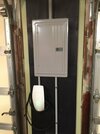Honestly I think the GFCI rule should be changed for wall connectors. Who am I? This is just in my opinion if you hook up a wall charger not a mobile charger. It's a fixed device and you're not plugging and unplugging it ever.
It doesn't need to be changed, because that's already how it is! That code rule in NEC says that only a "receptacle" being installed for EV charging must use the GFCI breakers. Hard wired devices do not require that. And yes, it's for that reason that you brought up. They are not being unplugged, and there aren't wires or prongs exposed where people could touch them.
Would love to know how using a properly installed 14-30 or 14-50 receptacle is considered cheap and a fire risk.
Since you would love to know, here is the thread where you can learn all about it:
Hey everyone, this might seem like a stupid question, but when installing a 14-50 outlet, at what height from the floor should I install it at? Mine is 50-inches above the concrete pad (on my carport). Fifty inches from the concrete to top of the outlet box. Ground up, that way the UMC hangs...

teslamotorsclub.com
The cheap Leviton receptacle is garbage in at least three specific ways. The metal pieces inside that touch the prongs of a plug are narrower than most of the better brands, so it's a smaller connection point with the prongs of the plug that's in it, so less contact, more resistance and heat. Also, the mechanism that keeps tension on those pieces is weaker, so it does wear out faster. And the main one is that the screw mechanisms on the back for clamping onto the wires are just a flat screw, and when tightened onto the wires have a tendency to splay the strands of the wires out, losing contact with the screw, so it tends to cause bad loose wire connections. The better outlets force the wire into angled or cupped type of brackets, so as the screw is tightened, it forces the strands together, keeping a tighter connection.
So that is the key there when you used the phrase "properly installed". With the garbage Leviton outlet, it makes it much harder to get a proper install.
If you choose to use a wall connector, cool, but using a charger plugged in to a 14-30 or 14-40 is not any more dangerous.
It is. Just fundamentally the squeeze tension or a plug in a receptacle is weaker and more resistive than a hard wired screwed down wire in a lug. It always will be, so anything plug connected is going to be a bit weaker connection. And that is progressively more of a risk for higher current applications. That's why electric code has a maximum level of 60A for receptacles. The weak connection of plug in receptacle is too risky for higher amp stuff.
If it were, then anyone who has an electric dryer or electric range are just waiting for a fire to occur?
You're not being rational here. We're talking comparative. One thing can be worse or riskier than something else (comparative), without meaning that it is automatically horrifically dangerous. Two things can both be pretty safe, but one is safer than the other.
Will also edit since I noticed you had your connector wired with aluminum, not copper wire; hypocrite?
Instead of name calling and insulting, it would help to get the full picture. Here's what was said:
running 150 ft of #2 aluminum four conductor cable from my 200 amp basement breaker panel to my garage.
He said that was to his garage.
@Kairide you made the assumption that meant that it was aluminum all the way into the final device, but he did not say that. This is a common and acceptable way to do long installation runs over 100 feet. Breakers and subpanels do have lugs that are made to take either copper or aluminum. So you can do most of the distance of a circuit for 150 feet with aluminum to get to a subpanel in the garage. And then you finish off the last several feet with a copper connection to the outlet or wall connector.
*EDIT*
@Rocky_H, disagreements are all part of the back and forth in a forum. It would be helpful though to add insight to what your point of view is rather then just clicking a button.
It would be helpful for you have a touch of patience while I am typing and posting my response. I'm not just shooting snarky one-liners like you're doing.



